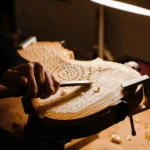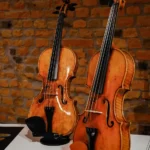Cello Price Guide: Professional Cellos for Sale and Pricing
Back to BlogCello Price Guide
Playing the cello is a captivating journey that intertwines skill, passion, and artistry. Are you aware of the factors that influence the cost of a cello? From affordable beginner cellos that cost thousands of dollars to inspiring multimillion-dollar masterpieces crafted by old renowned cello makers. The price range in the cello market is very vast. Understanding how this market works is extremely important for both buyers and sellers.
In this blog post, we will explore the factors that influence the cost of cellos, looking at different price ranges and providing insightful information on finding the perfect cello within your budget. Whether you are a beginner just starting out on your musical journey, a professional cellist seeking an excellent instrument, or a seller looking for the perfect cello investment, understanding the cello market and its price dynamics will help you make informed decisions. Let’s uncover the secrets behind cello prices and the various aspects that contribute to the cost of these magnificent musical instruments.
Factors Influencing Cello Pricing
Craftsmanship and Luthier Reputation
One of the primary factors that significantly affect the price of a cello is the craftsmanship and the luthier’s reputation. Cellos that are factory-made or made by unknown luthiers will be cheaper. In contrast, cellos made using excellent craftsmanship techniques or by a well-known luthier with an excellent reputation will cost more.
Quality of Materials
The quality of the wood used in its construction will also greatly influence the cost. Wood is the soul of a cello, and its origin, age, and characteristics play a pivotal role in determining the instrument’s overall value.
Age and Historical Significance
Of course, the cello’s age and historical significance must also be considered. An older cello with historical significance (for example, made by a famous luthier, played by a famous musician, or owned by a renowned collector) is an integral part of musical heritage and a work of art that a museum may own.
Condition and Maintenance
An older or used cello that does not have crucial historical significance must be kept in optimal condition for a higher market price. Musicians and sellers need to carefully observe the general condition and playability of the cello before investing in it.
Sound Quality and Tone
Cellos have different tonal qualities, from rich and deep tones to sweeter and lighter tones. The sound that a cello makes will also influence its price. Cellos made from higher-quality materials will usually have better sound quality. Older cellos made using fine materials and kept in top conditions typically have a better “voice,” as stringed instruments tend to open up more with time.
Market Demand and Trends
Last but not least, market demands and trends will also influence the price of a cello. Just like with most things, when a product is more in demand, the price will increase, especially regarding handcrafted fine instruments, the supply of which is not unlimited.
Types of Professional Cellos
Student vs. Intermediate vs. Professional Cellos
We do not recommend buying a factory-made carbon fiber or aluminum cello. The low price may seem alluring to students, but the sound and quality of the instrument will not be good, and it will have to be upgraded after a short period to improve playability. There are better quality student-friendly cellos that are handcrafted using tonewoods. These are perfect for beginners as they are affordable but may not suit the range and responsiveness an intermediate or professional player is looking for. For intermediate players, an ideal cello will be made out of spruce and maple and should be able to make rounder tones with greater nuance and color. Professional musicians need an instrument that has an expressive range and speaks quickly; what may suit them is an antique cello made by a master maker or a contemporary cello made by an expert luthier.
Differentiating between Soloist and Orchestra Cellos
When searching for a new cello to play, an important aspect is whether it will be a solo cello or part of an orchestra. Soloist cellos need to have a higher range and richer tonal qualities as they are the show’s stars. Musicians looking for this kind of instrument must invest more as they will need a higher quality cello with a more profound and powerful “voice.” On the other hand, orchestra cellos may have lower timbres as they are playing in a group, but they should still be chosen carefully as it is equally essential for them to have the right sound.
Antique and Modern Cellos: Pros and Cons
Professional players usually choose an antique cello or a modern fine cello. There are pros and cons to both; let’s take a look.
Antique cellos tend to have their “voice” already as cellos open up over time, while modern cellos need to be played for a while before we can hear their true sound. Musical enthusiasts (both players and collectors) will also love owning one of these instruments due to their rich history and the heritage they transmit. The price of an antique cello will be higher than a modern cello and will usually require more maintenance and special care, while a modern cello would possibly be in better shape. Both cellos will increase their value over time as they are important historical artifacts and are an excellent investment. Overall, there is no better choice between the two; it comes down to what sound you are looking for, your budget, and your personal taste.
Common Cello Price Ranges
Entry-Level Professional Cellos
Entry-level professional cellos can cost anywhere from $1500 to $5000; these are cellos that are usually factory-made with some finishing by hand and will be made out of tonewoods. They are well suited for entry-level players as their low price will produce an adequate sound for beginners.
Mid-Range Professional Cellos
Mid-range professional cellos will have a price range between $5000 and $30,000; they will be more refined, and some may even be entirely handmade by a craftsman. These are an excellent choice for intermediate players as they will produce rich sounds without breaking the bank.
High-End Professional Cellos
High-end professional cellos can cost anywhere from $30,000 to millions of dollars. These will be handmade by luthiers using high-quality materials and will, therefore, produce greater tonal qualities. The range in price ultimately depends on who they were made by; emerging luthiers will usually make lower-priced cellos; the higher the price, the more famed and expert the luthier will be. Obviously, antique cellos will be in the highest price range due to their important historical significance.
Protecting Your Investment
Proper Storage and Maintenance
In order for your cello to be preserved in top conditions over time, you must take proper care of it. Always be careful not to bump it into anything; this can damage the varnish, crack the wood, break the bridge, or cause a seam to come unglued. The best kind of case to store your cello in is a hard case as it will last longer and protect it better. Cellos are very sensitive to changes in humidity; the ideal humidity levels are between 50% and 60%. If the humidity is lower than 25%, use a humidifier such as Dampit, which can be used inside the instrument, allowing water to evaporate there. If the humidity is too high, let your cello stay out in the sun a little bit, but avoid the hottest hours of the day, as too much sun will damage your instrument. Remember to have your cello regularly checked on by a luthier and to have the strings and fittings upgraded when necessary.
Insurance and Documentation
Investing in insurance for your cello may seem like an added expense, but it will be less than the pricey repairs you will have to pay if your instrument is damaged. Insurance will protect your instrument against damage, theft, fire, or any accidents that may happen to it. Once you have found the right insurance, make sure to keep all documentation, such as receipts and appraisals, as these will be important for the insurer to know the value of your instrument and any eventual damage they have to reimburse.
Evaluating Resale Value
An important factor when investing in a cello is evaluating the resale value. This is the potential value your instrument will acquire over time. It is especially important to consider this when you are buying a fine instrument that is worth a lot or if you are buying a cello specifically as an investment that you want to make money out of. In any case, experts in the field, such as appraisers, can help you with this; remember to ask about the resale value when you are buying a new instrument.
In conclusion, choosing a cello is a personal journey; no matter if you are a musician, collector, or seller, what works for one person may not necessarily be the best fit for another. The key here is to be well-informed on the topic and combine expert advice with your own preferences. Study the market, get an appraisal, learn how to negotiate, and be as informed as possible on the types of cellos available before you decide to buy or sell.
At Amorim Fine Violins, we offer some exceptional cellos made by Luiz Amorim for sale. We are also always available to offer consultation, appraisals, and restoration services for your cello.
Talk with us about our Cellosor see our collection of Cellos here









